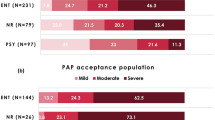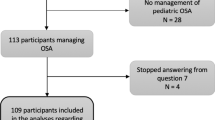Abstract
Sleep nasendoscopy was conceived at the Royal National Throat, Nose and Ear Hospital, UK in 1991, and has remained fully implemented in patient selection for targeted treatment of the spectrum of sleep-disordered breathing. The senior authors (B.T.K. and P.B.) have been performing sleep nasendoscopy together for over 10 years, and we look back at their decade’s experience. A retrospective audit study based on case notes was performed over a 10-year period (1995–2005) in a tertiary-referral practice setting. Case notes were retrieved on all patients who had undergone sleep nasendoscopy during the study period, and agreed data were extracted and analyzed. A total of 2,485 sleep nasendoscopies were performed in patients with a mean age of 44.1 years, a 4:1 male preponderance, and a mean body mass index of 27.3 kg m−2. Sleep nasendoscopy grading correlated well with apnoea–hypopnoea index and mean oxygen desaturation. Such grading helped us define and discuss treatment options with patients. After a median follow-up period of 518 days, 72% of patients reported feeling better; 26% of patients reported no change; and only 2% of patients reported feeling worse after treatment. Sleep nasendoscopy has proved to be a useful adjunctive method to identify the anatomical site of snoring, not to mention upper airway collapse, and remains integral to our tertiary-referral practice. It has allowed us quality assessment of the dynamic anatomy of sleep-disordered breathing that most closely and cost-effectively simulates the natural situation of patients. And for targeted treatment, such assessment has been fundamental.




Similar content being viewed by others
References
Sher AE, Thorpy MJ, Shprintzen RJ, Spielman AJ, Burack B, McGregor PA (1985) Predictive value of Muller maneuver in selection of patients for uvulopalatopharyngoplasty. Laryngoscope 95:1483–1487
Riley R, Guilleminault C, Herran J, Powell N (1983) Cephalometric analyses and flow-volume loops in obstructive sleep apnoea patients. Sleep 6:303–311
Haponik EF, Smith PL, Bohlman ME, Allen RP, Goldman SM, Bleecker ER (1983) Computerized tomography in obstructive sleep apnoea. Correlation of airway size with physiology during sleep and wakefulness. Am Rev Respir Dis 127:221–226
Hasegawa K, Nishimura T, Yagisawa M, Morishima N, Shibata N, Iwanaga K (1996) Diagnosis by dynamic MRI in sleep disordered breathing. Acta Otolaryngol Suppl 523:245–247
Skatvedt O (1995) Continuous pressure measurements during sleep to localize obstructions in the upper airways in heavy snorers and patients with obstructive sleep apnoea syndrome. Eur Arch Otorhinolaryngol 252:11–14
Quinn SJ, Huang L, Ellis PD, Williams JE (1996) The differentiation of snoring mechanisms using sound analysis. Clin Otolaryngol 21:119–123
Borowiecki B, Pollak CP, Weitzman ED, Rakoff S, Imperato J (1978) Fibro-optic study of pharyngeal airway during sleep in patients with hypersomnia obstructive sleep-apnoea syndrome. Laryngoscope 88:1310–1313
Croft CB, Pringle M (1991) Sleep nasendoscopy: a technique of assessment in snoring and obstructive sleep apnoea. Clin Otolaryngol 16:504–509
Berry S, Roblin G, Williams A, Watkins A, Whittet HB (2005) Validity of sleep nasendoscopy in the investigation of sleep related breathing disorders. Laryngoscope 115:538–540
Pringle MB, Croft CB (1993) A grading system for patients with obstructive sleep apnoea-based on sleep nasendoscopy. Clin Otolaryngol 18:480–484
Battagel JM, Johal A, Kotecha BT (2005) Sleep nasendocopy as a predictor of treatment success in snorers using mandibular advancement splints. J Laryngol Otol 119:106–112
Kotecha B, Paun S, Leong P, Croft CB (1998) Laser assisted Uvulopalatoplasty: an objective evaluation of the technique and results. Clin Otolaryngol 23:354–359
Iyngkaran T, Kanagalingam J, Rajeswaran R, Georgalas C, Kotecha B (2006) Long-term outcomes of laser-assisted uvulopalatoplasty in 168 patients with snoring. J Laryngol Otol 120:932–938
Chisholm E, Kotecha B (2007) Oropharyngeal surgery for obstructive sleep apnoea in CPAP failures. Eur Arch Otorhinolaryngol 264:51–55
Hill PD, Osman EZ, Osbourne JE, Lee BWV (2000) Changes in snoring during natural sleep identified by acoustic crest factor analysis at different times of night. Clin Otolaryngol 25:507–510
Agrawal S, Stone P, McGuinness K, Morris J, Camilleri AE (2002) Sound frequency analysis and the site of snoring in natural and induced sleep. Clin Otolaryngol 27:162–166
Jones TM, Ho MS, Earis JE, Swift AC, Charters P (2006) Acoustic parameters of snoring sound to compare natural snores with snores during ‘steady-state’ propofol sedation. Clin Otolaryngol 31:46–52
Saunders NC, Tassone P, Wood G, Norris A, Harries M, Kotecha B (2004) Is acoustic analysis of snoring an alternative to sleep nasendoscopy? Clin Otolaryngol 29:242–246
Author information
Authors and Affiliations
Corresponding author
Rights and permissions
About this article
Cite this article
Kotecha, B.T., Hannan, S.A., Khalil, H.M.B. et al. Sleep nasendoscopy: a 10-year retrospective audit study. Eur Arch Otorhinolaryngol 264, 1361–1367 (2007). https://doi.org/10.1007/s00405-007-0366-1
Received:
Accepted:
Published:
Issue Date:
DOI: https://doi.org/10.1007/s00405-007-0366-1




